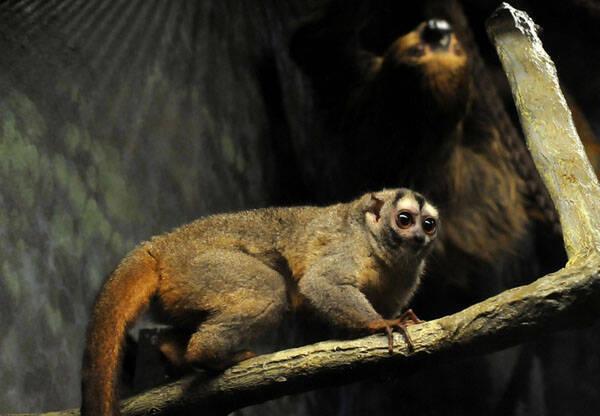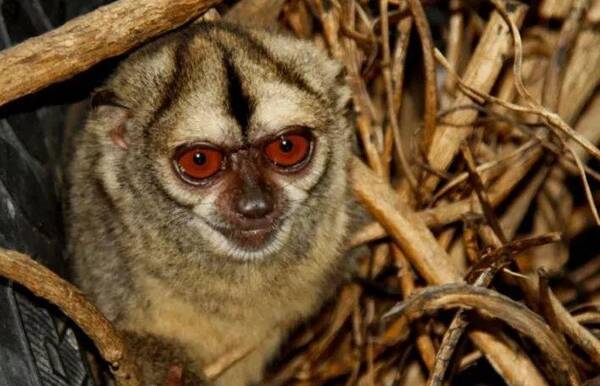Aotus lemurinus
IUCN
LCBasic Information
Scientific classification
- name:Aotus lemurinus
- Scientific Name:Aotus lemurinus,Colombian Night Monkey,Gray-bellied Night Monkey
- Outline:Primates
- Family:N.monkeys
Vital signs
- length:24-47cm
- Weight:875-920g
- lifetime:No verification information
Feature
The only truly nocturnal monkey in the world
Distribution and Habitat
Distributed in Central and South America. From Panama to northeastern Argentina, from Peru and Ecuador to Guyana and Brazil.
The night monkey inhabits the tropical rainforests of South America, and is found at altitudes ranging from 1,000 to 3,200 meters. They are nocturnal and arboreal animals, sleeping during the day in tree holes or tree nests in woody vines.
Appearance
The Aotus is the only monkey in the world that is truly active at night. The scientific name "Aotus" means "earless", and this name is because these monkeys have small ears that are often hidden in their fur, not earless.
They have a pair of big round eyes, the irises of which show a beautiful mixture of red, yellow, and brown. There are white chin hairs around the eyes, and brown-black forehead hairs above the eyes, which complement each other and look even more beautiful; the eyeballs are bulging, and the surface of the eyeballs is covered with a layer of transparent cornea, like a big glass ball; what's more strange is that its eyes have a strong ability to gather light, and it can still catch flying insects in a nearly dark environment. Its face is often very similar to that of an owl, with thick, furry yellow-gray fur on its back, pale orange chest and abdomen, and a long, thick, hard black tail.
Details
Aotus lemurinus (scientific name: Colombian Night Monkey) is a species of Aotus lemurinus. It has a very strange appearance and two subspecies.

Aotus lemurinus is most active in the hours before dusk and dawn. These monkeys live in small groups of 2-5 members, including a pair of adult monkeys and their offspring. They spend most of their time in the treetops 30 meters above the ground. Males and females live together, and males are responsible for defending the territory. They are monogamous, and both parents raise their young together.
The ghost night monkeys have a very diverse diet, eating wild fruits, insects, snails, tree frogs, bird eggs, and honey. But they eat very carefully, always taking it in front of their eyes to check before eating. When eating insects, they quietly pinch the wings of the insect with the thumb and index finger of their hands, and then break the insect's neck with the same two fingers of the other hand, and then eat it slowly.
The calls of the ghost night monkeys are complex and varied, which are amazing. They can not only make "chirp chirp" screams, but also make "rumble" sounds like thunder, and there are also "bang bang" sounds like beating gongs. Their calls are sometimes high and sometimes low, and they are varied, causing loud echoes in the dense forest. This complex and varied call is very unique in the monkey family.
Ghost night monkeys reach sexual maturity at about 2.5 years old. The female ovulation cycle is 13-19 days. There are no external signs of estrus. Before mating, the species will groom each other's hair. The gestation period is 133 days. Females give birth to one or twins.

The distribution range of the ghost night monkey is narrow and limited, and it is believed that there is a trend of moderate population decline. The reason for the decline is that the living environment has changed due to habitat loss, reduced precipitation, tourism impact, road development, and agricultural land development. It has been listed as a vulnerable species.
Scientists recently announced that they have discovered a new variant of the night monkey in northern Peru. The new species, found near the border with Ecuador, has not yet been named, said expedition leader Gerardo Ceballos of the National Autonomous University of Mexico. Compared with the other two night monkeys in the area, this new species has more uniform coloration and a smaller head. The night monkey is an endangered species, which makes this new discovery particularly noteworthy.
Listed in the IUCN Red List of Primates ver.: 2008 - Vulnerable (VU).
Protect wild animals and stop eating game.
Maintaining ecological balance is everyone's responsibility!








